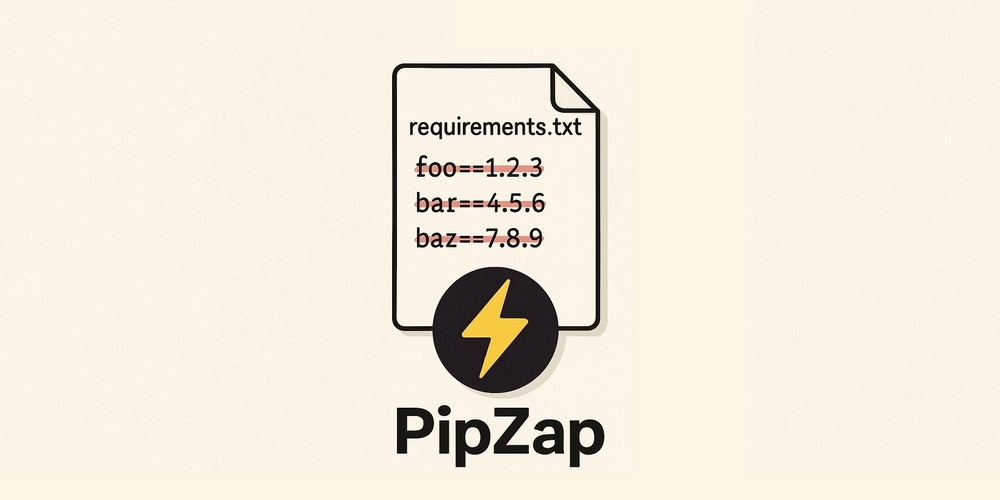⚡️PipZap: Zapping the mess out of the Python dependencies
Python's package management has always been a blessing and a curse to the community. Tools like pip initially made installing libraries effortless, but managing isolated environments soon revealed their limitations. While virtual environments provided some relief, the complexity of maintaining clean, reproducible setups continued to grow – but that’s a topic for another time. The Big Problem First, there was pip. Combined with a requirements.txt, it seemed like a great idea – a straightforward method to declare dependencies explicitly. Luckily, we quickly realized this method tends to spiral into chaos, particularly when developers use "tricks" like pip freeze to lock dependencies rigidly. Fortunately, the Python ecosystem has evolved, introducing modern solutions like Poetry and now uv, offering structured dependency management, better version control, and adherence to standards like PEP 621. Yet, despite these advancements, numerous projects, even actively maintained ones, continue to rely heavily on messy requirements.txt files. This can be seen throughout countless ML-related projects, where it not only hurts the aesthetics but is a real problem, making adopting many great projects a great pain. Obviously, this problem isn't exclusive to ML – it affects virtually all the Python domains, creating maintenance headaches across the board. Why it Matters? A messy requirements.txt — especially from pip freeze — locks you into bloated, rigid setups. Updates and patches? Tough. Collaboration? A nightmare. Users face conflicts, tricky version fixes, and installation headaches. Modern tools like pyproject.toml do it better, but old habits drag us down. Enter ⚡️PipZap PipZap addresses exactly these problems. It analyzes and prunes redundant, transitive dependencies, transforming cumbersome requirements.txt files into sleek, minimalistic dependency declarations compatible with Poetry or uv’s pyproject.toml. It's not limited to just the requirements files as input – it can also filter existing pyprojects. While discouraged, you can still keep the requirements.txt as an output as a matter of completeness. Consider the easy_ViTPose project as a clear example. It's a great wrapper of a SOTA recognition model, but look at its requirements.txt – it's a mess with 50 pinned dependencies: # A/N: not truncated to paint the picture certifi==2023.7.22 charset-normalizer==3.2.0 coloredlogs==15.0.1 contourpy==1.1.1 cycler==0.11.0 ffmpeg==1.4 filelock==3.12.4 filterpy==1.4.5 flatbuffers==23.5.26 fonttools==4.43.0 humanfriendly==10.0 idna==3.4 imageio==2.31.3 importlib-resources==6.1.0 jinja2>=3.1.3 kiwisolver==1.4.5 lazy_loader==0.3 MarkupSafe==2.1.3 matplotlib==3.8.0 mpmath==1.3.0 networkx==3.1 numpy==1.26.0 onnx==1.14.1 onnxruntime==1.16.0 opencv-python==4.8.0.76 packaging==23.1 pandas==2.1.1 Pillow>=10.2.0 protobuf==4.24.3 psutil==5.9.5 py-cpuinfo==9.0.0 pycocotools==2.0.8 pyparsing==3.1.1 python-dateutil==2.8.2 pytz==2023.3.post1 PyWavelets==1.4.1 PyYAML==6.0.1 requests==2.31.0 scikit-image==0.21.0 scipy==1.11.2 seaborn==0.12.2 six==1.16.0 sympy==1.12 tifffile==2023.9.18 tqdm==4.66.1 typing_extensions==4.8.0 tzdata==2023.3 ultralytics==8.2.48 urllib3>=2.0.7 zipp==3.17.0 The reason why I chose this project as an example is a little sentimental - it was my snapping point to start developing PipZap when I had to integrate this into my project and found that the above requirements.txt is not even included in the setup.py. Now, let's apply PipZap to it (pipzap requirements.txt -f uv), and here is the beauty we get as a result: [project] name = "easy_ViTPose" version = "1.1" requires-python = "~=3.11" dependencies = [ 'ffmpeg==1.4', 'filterpy==1.4.5', 'importlib-resources==6.1.0', 'onnx==1.14.1', 'onnxruntime==1.16.0', 'pycocotools==2.0.8', 'scikit-image==0.21.0', 'ultralytics==8.2.48', 'zipp==3.17.0', ] A nice, clean, manageable dependencies list. Of course, a few things can still be done manually to achieve perfection, but at this stage, it is both possible and feasible, unlike before. How PipZap Works PipZap is designed to work with the three most common dependency formats as of now: bare requirements, poetry, and uv. To achieve this, uv was chosen as an intermediate and universal representation. Luckily, it has the necessary tools to auto-convert other formats into it. Once the uv representation is obtained, PipZap parses the full declaration and the lock, resolves the dependency graph, identifies unnecessary transitive dependencies, and prunes them. Finally, it re-formats the remaining dependencies into the requested output format and hands the user a new and concise dependency list. Whether refactoring a legacy project, managing your team's dependencies, or incorporating external libraries, PipZap can help you streamline the process. Comparing PipZap to Existing Tools Several tools already address vario

Python's package management has always been a blessing and a curse to the community. Tools like pip initially made installing libraries effortless, but managing isolated environments soon revealed their limitations. While virtual environments provided some relief, the complexity of maintaining clean, reproducible setups continued to grow – but that’s a topic for another time.
The Big Problem
First, there was pip. Combined with a requirements.txt, it seemed like a great idea – a straightforward method to declare dependencies explicitly. Luckily, we quickly realized this method tends to spiral into chaos, particularly when developers use "tricks" like pip freeze to lock dependencies rigidly. Fortunately, the Python ecosystem has evolved, introducing modern solutions like Poetry and now uv, offering structured dependency management, better version control, and adherence to standards like PEP 621.
Yet, despite these advancements, numerous projects, even actively maintained ones, continue to rely heavily on messy requirements.txt files. This can be seen throughout countless ML-related projects, where it not only hurts the aesthetics but is a real problem, making adopting many great projects a great pain. Obviously, this problem isn't exclusive to ML – it affects virtually all the Python domains, creating maintenance headaches across the board.
Why it Matters?
A messy requirements.txt — especially from pip freeze — locks you into bloated, rigid setups. Updates and patches? Tough. Collaboration? A nightmare. Users face conflicts, tricky version fixes, and installation headaches. Modern tools like pyproject.toml do it better, but old habits drag us down.
Enter ⚡️PipZap
PipZap addresses exactly these problems. It analyzes and prunes redundant, transitive dependencies, transforming cumbersome requirements.txt files into sleek, minimalistic dependency declarations compatible with Poetry or uv’s pyproject.toml. It's not limited to just the requirements files as input – it can also filter existing pyprojects.
While discouraged, you can still keep the
requirements.txtas an output as a matter of completeness.
Consider the easy_ViTPose project as a clear example. It's a great wrapper of a SOTA recognition model, but look at its requirements.txt – it's a mess with 50 pinned dependencies:
# A/N: not truncated to paint the picture
certifi==2023.7.22
charset-normalizer==3.2.0
coloredlogs==15.0.1
contourpy==1.1.1
cycler==0.11.0
ffmpeg==1.4
filelock==3.12.4
filterpy==1.4.5
flatbuffers==23.5.26
fonttools==4.43.0
humanfriendly==10.0
idna==3.4
imageio==2.31.3
importlib-resources==6.1.0
jinja2>=3.1.3
kiwisolver==1.4.5
lazy_loader==0.3
MarkupSafe==2.1.3
matplotlib==3.8.0
mpmath==1.3.0
networkx==3.1
numpy==1.26.0
onnx==1.14.1
onnxruntime==1.16.0
opencv-python==4.8.0.76
packaging==23.1
pandas==2.1.1
Pillow>=10.2.0
protobuf==4.24.3
psutil==5.9.5
py-cpuinfo==9.0.0
pycocotools==2.0.8
pyparsing==3.1.1
python-dateutil==2.8.2
pytz==2023.3.post1
PyWavelets==1.4.1
PyYAML==6.0.1
requests==2.31.0
scikit-image==0.21.0
scipy==1.11.2
seaborn==0.12.2
six==1.16.0
sympy==1.12
tifffile==2023.9.18
tqdm==4.66.1
typing_extensions==4.8.0
tzdata==2023.3
ultralytics==8.2.48
urllib3>=2.0.7
zipp==3.17.0
The reason why I chose this project as an example is a little sentimental - it was my snapping point to start developing PipZap when I had to integrate this into my project and found that the above
requirements.txtis not even included in thesetup.py.
Now, let's apply PipZap to it (pipzap requirements.txt -f uv), and here is the beauty we get as a result:
[project]
name = "easy_ViTPose"
version = "1.1"
requires-python = "~=3.11"
dependencies = [
'ffmpeg==1.4',
'filterpy==1.4.5',
'importlib-resources==6.1.0',
'onnx==1.14.1',
'onnxruntime==1.16.0',
'pycocotools==2.0.8',
'scikit-image==0.21.0',
'ultralytics==8.2.48',
'zipp==3.17.0',
]
A nice, clean, manageable dependencies list. Of course, a few things can still be done manually to achieve perfection, but at this stage, it is both possible and feasible, unlike before.
How PipZap Works
PipZap is designed to work with the three most common dependency formats as of now: bare requirements, poetry, and uv. To achieve this, uv was chosen as an intermediate and universal representation. Luckily, it has the necessary tools to auto-convert other formats into it.
Once the uv representation is obtained, PipZap parses the full declaration and the lock, resolves the dependency graph, identifies unnecessary transitive dependencies, and prunes them. Finally, it re-formats the remaining dependencies into the requested output format and hands the user a new and concise dependency list.
Whether refactoring a legacy project, managing your team's dependencies, or incorporating external libraries, PipZap can help you streamline the process.
Comparing PipZap to Existing Tools
Several tools already address various challenges in Python dependency management, primarily focusing on generating and maintaining requirements.txt files:
-
pipreqs: Automatically generates a minimal
requirements.txtby scanning project imports, targeting direct dependencies. It's helpful but can miss dependencies in complex scenarios or dynamic imports. -
pip-tools: Offers tools like
pip-compileto pin all dependencies, including transitive ones, into a reproduciblerequirements.txt. It significantly enhances traditional dependency management but remains tied to the older paradigm.
What Sets PipZap Apart
PipZap differentiates itself with a fresh approach, specifically targeting common pain points missed by other tools:
- Pruning: PipZap analyzes your dependency declarations, identifying and removing unnecessary transitive dependencies. This leads to significantly cleaner, more maintainable declarations.
-
Smooth Migration: It doesn't just manage existing requirements; PipZap actively facilitates transitioning projects away from
requirements.txttoward modern standards likepyproject.toml, aligning with best practices and standards such as PEP 621. - Future-Oriented: Rather than optimizing the old system, PipZap advocates for completely embracing modern dependency management practices, ensuring projects stay maintainable and scalable over the long term.
Final Thoughts
With PipZap, Python developers can finally eliminate dependency chaos. Keep your project dependencies lean, simplify maintenance, and improve usability for anyone interacting with your code. Let PipZap tidy up your dependency jungle, and let your project's quality speak clearly.
Bonus
One initially unintended but emergent use case might be transitioning a project from rapid prototyping to a more manageable, mature setup without worrying about the proper organization from the start. Simply develop the project as you go, and when the time comes, generate pip freeze > requirements.txt, then immediately clean it up with:
pipzap requirements.txt -f uv
Links
- ⚡️ PipZap – Streamline your Python dependencies effortlessly.




















































%20Abstract%20Background%20112024%20SOURCE%20Amazon.jpg)






















































































































![[The AI Show Episode 142]: ChatGPT’s New Image Generator, Studio Ghibli Craze and Backlash, Gemini 2.5, OpenAI Academy, 4o Updates, Vibe Marketing & xAI Acquires X](https://www.marketingaiinstitute.com/hubfs/ep%20142%20cover.png)
























































































































































































































































-Nintendo-Switch-2-–-Overview-trailer-00-00-10.png?width=1920&height=1920&fit=bounds&quality=80&format=jpg&auto=webp#)





















_Anna_Berkut_Alamy.jpg?#)













































































































![YouTube Announces New Creation Tools for Shorts [Video]](https://www.iclarified.com/images/news/96923/96923/96923-640.jpg)





































































![[Weekly funding roundup March 29-April 4] Steady-state VC inflow pre-empts Trump tariff impact](https://images.yourstory.com/cs/2/220356402d6d11e9aa979329348d4c3e/WeeklyFundingRoundupNewLogo1-1739546168054.jpg)





























































